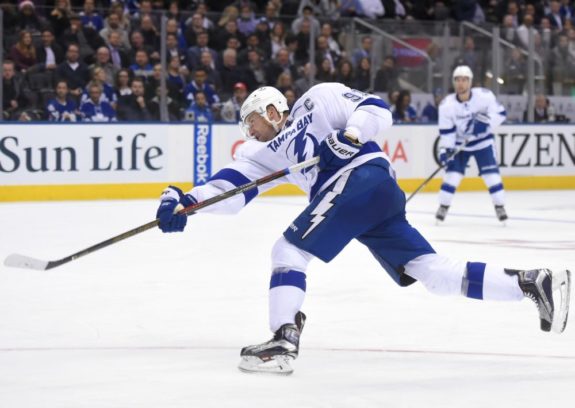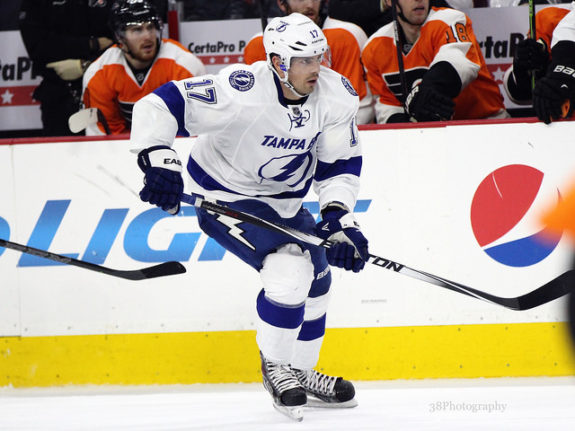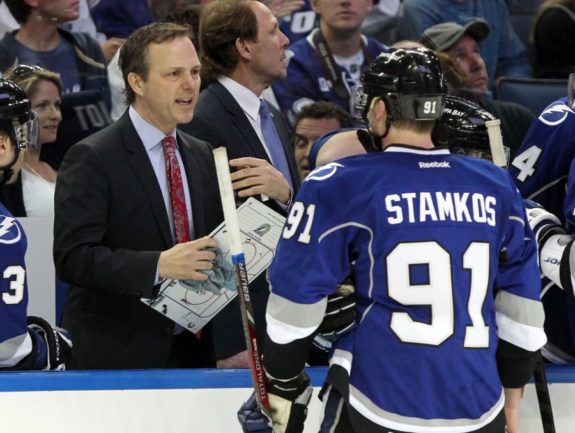The Tampa Bay Lightning have scored 36 goals through nine games this season. It’s the second-most in the NHL behind the Toronto Maple Leafs, who have found the back of the net 40 times in the same span.
While the Lightning’s offensive output isn’t all that surprising at this point in the new season, one thing is: Steven Stamkos has tallied just three goals. In fact, 23 goals have been scored by Lightning players other than Stamkos or Nikita Kucherov.

But it’s not for a lack of production from Stamkos, the two-time Rocket Richard Trophy winner. He’s pacing all NHL players with 15 assists and 18 points and his chemistry with linemates Kucherov and Vladislav Namestnikov has been a big part of the team’s success in the early going. If you’ve paid attention to the way Stamkos is playing now, you’d have a hard time believing he’s played just 26 regular season games and one playoff contest since April 1, 2016.
Here is why receiving offensive production from the Lightning’s depth is important for the club, whether or not Stamkos is scoring goals.
Depth Scoring Makes a Difference
To be a serious Stanley Cup contender, you absolutely have to have depth up and down your roster. But depth alone isn’t enough. You need those players who will step up and chip in goals when other players aren’t (or go down with injury).
If you want a good example of why it makes a difference, look at how the Lightning’s depth forwards performed when Stamkos went down with his blood clot injury at the tail end of the 2015-16 regular season vs. when he was lost to a knee injury 17 games into 2016-17.
The 2016 Stanley Cup Playoff Run
When Stamkos went down with his blood clot injury in April 2016, the Lightning dropped three of their last five regular-season games, but earned a playoff berth and took off from there.
Players like Jonathan Drouin, Tyler Johnson, Alex Killorn, Kucherov and Ondrej Palat stepped up and picked up some of the slack without Stamkos in the lineup. They also got some goals from other depth forwards like Brian Boyle and Ryan Callahan, among others.

Even after losing goaltender Ben Bishop to injury in Game 1 of the Eastern Conference Final, they had the Pittsburgh Penguins down to the brink of elimination before dropping two straight to fall in seven games.
Drouin would finish the playoffs with five goals and nine assists in 19 games, Johnson had 17 points in as many games, Killorn chipped in 13 points and Palat added 10. Between the offensive contributions of the team’s forwards and Vasilevskiy’s performance in goal, the team showed they could hang with just about anyone, even without their captain in the lineup.
The 2016-17 Regular Season
When Stamkos was lost for the season with a knee injury, he was playing arguably the best hockey of his career. He’d tallied 20 points through 17 games and the Lightning were 10-6-1 on the year.
But despite the team’s winning record at the time, they had a noticeably different feel than the season before. They were playing from behind to start a lot of games, struggling with defensive depth and not sticking to the style that had been one of their biggest strengths in seasons of the past.

When Stamkos went down with his injury, many believed that the team’s depth would be what would carry the club through the regular season. After all, this was virtually the same roster that handled the Detroit Red Wings and New York Islanders en route to the ECF the year before.
But things were much different last season.
Sure, the Lightning suffered a fairly continuous stream of injuries — resulting in a lot of call-ups from their AHL affiliate, the Syracuse Crunch — but there was more to it than that.
The depth scoring was not there regularly enough, the uncertainty of Ben Bishop’s future seemed to loom over the club more than even they might have expected it would and one could make the argument the team felt the effects of playing in seven playoff series’ and 43 postseason contests over the previous two seasons.

Despite Kucherov’s career year (40 goals and 85 points) and Victor Hedman scoring at nearly a point per game, other players did not perform at the levels the Lightning needed them to over the course of the season. In the goals department, the only other player besides Kucherov to score 20 or more was Drouin, who tallied 21. After Hedman’s 72 points, the next highest producer was Drouin with 53.
All of this resulted in the Lightning playing down to the wire in the regular season. Despite a strong finish and above average play from many young prospects down the stretch, the Lightning fell short of making their fourth consecutive trip to the playoffs.
The 2017-18 Regular Season
Stamkos and Kucherov are scoring points at a rapid rate, but the offensive production of the supporting cast is a difference-maker for the Lightning. Thirteen players have contributed goals in the season’s first nine games.

Of the team’s 23 goals not scored by Kucherov or Stamkos, Brayden Point has four, followed by Johnson, Namestnikov, Palat and rookie defenseman Mikhail Sergachev, who each have three. Outside of Kucherov and Stamkos’ combined 34 points, the Lightning have tallied 66 more, with Namestnikov and Point tied with 10 points each.
This sort of offensive production from across the roster can be an overlooked difference-maker for the club.
Steven Stamkos Will Score More Goals
It’s only a matter of time before Stamkos begins to score goals with more regularity, which does not bode well for the rest of the league — especially if the Lightning continue to receive the depth scoring they have. His career total of 324 goals in 595 contests is good for .54 goals per game and he will find his groove sooner than later.
But if you are Lightning right now, Stamkos and his teammates are doing exactly what they need to be doing to win games — and that’s all that matters.
Stamkos and Kucherov give the Lightning a 1-2 goal-scoring punch unmatched by any other combination in the league — regardless of if one is “cooler” in that department than the other at any given time. There isn’t a reason to split them up now, at least not regularly. Together, Stamkos, Kucherov and Namestnikov are averaging nearly five points per game (44 in nine contests).

But whenever Jon Cooper opts to juggle line combinations and separates Stamkos from Kucherov, this immediately changes the way the opposition approaches their matchups. This becomes especially more important when the Lightning play games at Amalie Arena. This is because NHL rules dictate the home team has the last chance to make changes to lines before the puck drops. Combine that with the team’s other offensive threats and it’s hard for other teams to defend.
Stamkos and Kucherov are each scoring points at a torrid pace, but if the Lightning can receive regular offensive contributions from other parts of their roster, they will continue to be a dangerous team to watch into April and beyond.